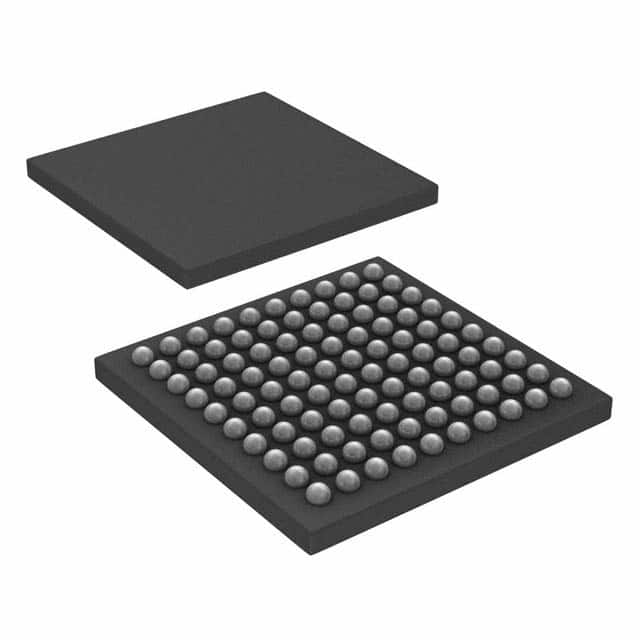Consulte las especificaciones para obtener detalles del producto.

AT91SAM7X256-CU-999
Overview
Product Category
AT91SAM7X256-CU-999 belongs to the category of microcontrollers.
Use
This microcontroller is commonly used in various electronic devices and embedded systems for controlling and processing data.
Characteristics
- High-performance 32-bit ARM architecture
- Clock speed of up to 55 MHz
- Flash memory capacity of 256 KB
- RAM capacity of 64 KB
- Multiple communication interfaces (UART, SPI, I2C)
- Analog-to-digital converter (ADC) with 10-bit resolution
- Real-time clock (RTC) functionality
- Low power consumption
- Small form factor
Package
AT91SAM7X256-CU-999 is available in a compact and durable package, suitable for surface mount technology (SMT) assembly.
Essence
The essence of this microcontroller lies in its powerful processing capabilities, extensive connectivity options, and low power consumption, making it ideal for a wide range of applications.
Packaging/Quantity
AT91SAM7X256-CU-999 is typically packaged in reels or trays, with quantities varying based on customer requirements.
Specifications
- Architecture: ARM7TDMI-S
- Clock Speed: Up to 55 MHz
- Flash Memory: 256 KB
- RAM: 64 KB
- Operating Voltage: 3.3V
- Communication Interfaces: UART, SPI, I2C
- ADC Resolution: 10-bit
- Timers/Counters: 6
- GPIO Pins: 53
- Operating Temperature Range: -40°C to +85°C
Detailed Pin Configuration
The pin configuration of AT91SAM7X256-CU-999 is as follows:
- VDDIO
- PA0
- PA1
- PA2
- PA3
- PA4
- PA5
- PA6
- PA7
- GND
- PB0
- PB1
- PB2
- PB3
- PB4
- PB5
- PB6
- PB7
- GND
- PC0
- PC1
- PC2
- PC3
- PC4
- PC5
- PC6
- PC7
- GND
- PD0
- PD1
- PD2
- PD3
- PD4
- PD5
- PD6
- PD7
- GND
- PE0
- PE1
- PE2
- PE3
- PE4
- PE5
- PE6
- PE7
- GND
- PF0
- PF1
- PF2
- PF3
- PF4
- PF5
- PF6
- PF7
- GND
- NRST
- VDDCORE
- VDDPLL
- VDDOSC
- VDDANA
- VDDPLLCK
- VDDPLLREF
- VDDUSB
- GND
Functional Features
- High-performance processing capabilities for efficient data handling
- Multiple communication interfaces for seamless connectivity with other devices
- Analog-to-digital converter for accurate measurement and sensing applications
- Real-time clock functionality for timekeeping and scheduling tasks
- Extensive GPIO pins for interfacing with external components
- Timers/counters for precise timing and event management
Advantages
- Powerful processing capabilities enable complex applications
- Extensive connectivity options facilitate integration with various devices
- Low power consumption for energy-efficient operation
- Compact form factor allows for space-saving designs
- Wide operating temperature range ensures reliability in harsh environments
Disadvantages
- Limited flash memory capacity may restrict the size of the software that can be stored
- The absence of certain advanced features found in higher-end microcontrollers
Working Principles
AT91SAM7X256-CU-999 operates based on the ARM7TDMI-S architecture. It executes instructions fetched from its flash memory, processes data, and communicates with other devices through its communication interfaces. The microcontroller's internal peripherals and GPIO pins allow it to interact with external components and perform various tasks as programmed.
Detailed Application Field Plans
AT91SAM7X256-CU-999 finds application in a wide range of fields, including but not limited to: - Industrial automation - Consumer electronics - Automotive systems - Medical devices - Internet of Things (IoT) applications - Robotics
Alternative Models
Several alternative models with similar capabilities to AT91
Enumere 10 preguntas y respuestas comunes relacionadas con la aplicación de AT91SAM7X256-CU-999 en soluciones técnicas
Sure! Here are 10 common questions and answers related to the application of AT91SAM7X256-CU-999 in technical solutions:
Q: What is the AT91SAM7X256-CU-999 microcontroller used for? A: The AT91SAM7X256-CU-999 microcontroller is commonly used in embedded systems and IoT applications.
Q: What is the maximum clock frequency supported by the AT91SAM7X256-CU-999? A: The AT91SAM7X256-CU-999 supports a maximum clock frequency of 55 MHz.
Q: How much flash memory does the AT91SAM7X256-CU-999 have? A: The AT91SAM7X256-CU-999 has 256 KB of flash memory.
Q: Can I expand the memory of the AT91SAM7X256-CU-999? A: Yes, the AT91SAM7X256-CU-999 supports external memory expansion through its memory bus interface.
Q: What peripherals are available on the AT91SAM7X256-CU-999? A: The AT91SAM7X256-CU-999 includes various peripherals such as UART, SPI, I2C, ADC, PWM, and timers.
Q: Does the AT91SAM7X256-CU-999 support USB connectivity? A: Yes, the AT91SAM7X256-CU-999 has a built-in USB 2.0 Full Speed device interface.
Q: Can I use the AT91SAM7X256-CU-999 for real-time applications? A: Yes, the AT91SAM7X256-CU-999 features a real-time timer (RTT) and supports real-time operating systems (RTOS).
Q: What development tools are available for programming the AT91SAM7X256-CU-999? A: The AT91SAM7X256-CU-999 can be programmed using various development tools such as Atmel Studio, Keil MDK, and GCC.
Q: Is the AT91SAM7X256-CU-999 suitable for low-power applications? A: Yes, the AT91SAM7X256-CU-999 offers multiple power-saving modes and features to optimize power consumption.
Q: Can I use the AT91SAM7X256-CU-999 in industrial environments? A: Yes, the AT91SAM7X256-CU-999 is designed to operate reliably in industrial temperature ranges and has built-in protection features.
Please note that the specific details and answers may vary depending on the context and requirements of your technical solution.

